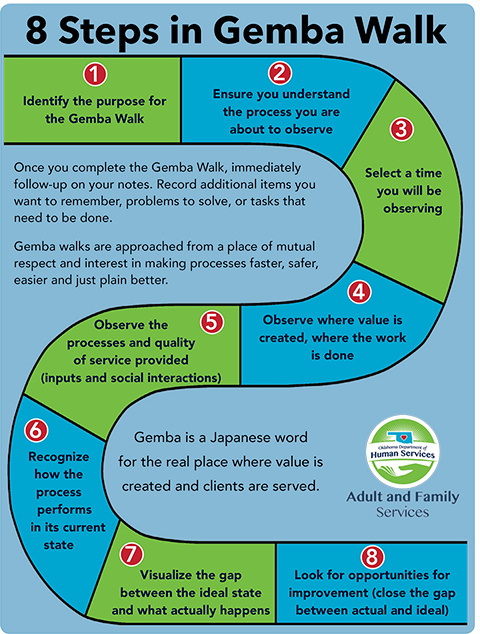Gemba Walk is a simple yet powerful tool that organizations can use to improve their processes and increase efficiency. The term “Gemba” is a Japanese word that means “the actual place” or “the real place.” Gemba Walk is a process where managers and other leaders go to the “Gemba,” or the place where work is being done, to observe and gather data about the processes and identify areas for improvement.

Gemba Walk is often used in conjunction with Lean and Six Sigma methodologies, which also focus on improving processes and increasing efficiency. By going to the “Gemba” and observing processes firsthand, leaders can gather valuable data that can be used to improve processes and increase efficiency.
There are several critical benefits to Gemba Walk:
- Improves communication: When leaders go to the “Gemba,” they can observe processes firsthand and talk to employees about their work. This enhances communication and helps leaders understand the challenges that employees face daily.
- Identifies areas for improvement: By observing processes firsthand, leaders can identify areas where processes can be improved. This allows them to make data-driven decisions that significantly improve efficiency and quality.
- Increases employee engagement: When employees see that their leaders are actively engaged in improving their work, it increases employee engagement and motivation.
- Helps to build a culture of continuous improvement: Gemba Walk is an ongoing process that helps to create a culture of continuous improvement within an organization.
To conduct a Gemba Walk, leaders should follow these steps:
- Choose a process to observe: Select a process that is critical to the organization’s success and that you would like to improve.
- Gather a team: Invite key stakeholders, such as employees, managers and other leaders, to participate in the walk.
- Observe and gather data: During the walk, observe the process and gather data on how it is being performed.
- Analyze data: After the walk, analyze the data and identify areas for improvement.
- Implement improvements: Based on the data gathered and analyzed, implement improvements to the process.
Gemba Walk is a simple yet powerful tool that organizations can use to improve their processes and increase efficiency. By going to the “Gemba” and observing processes firsthand, leaders can gather valuable data that can be used to make data-driven decisions and drive continuous improvement. By conducting regular Gemba Walks, organizations can build a culture of continuous improvement and increase efficiency, quality and customer satisfaction.

















As a manufacturing professional, I understand the importance of continuously improving processes to optimize efficiency and productivity. The Gemba Walk is a powerful tool that allows managers to identify areas of improvement and engage with employees to gather feedback and ideas. The post provides a clear and concise explanation of what a Gemba Walk is and how it can benefit an organization. I appreciated the practical tips and guidelines provided on how to conduct a successful walk.
Its really useful technique…Gives result 100%